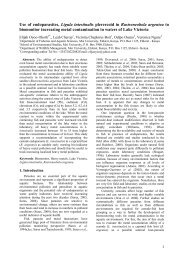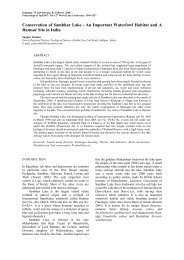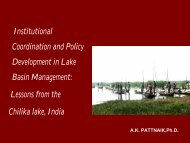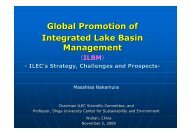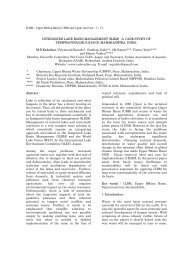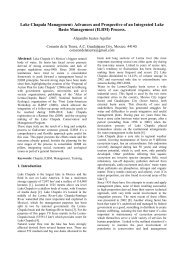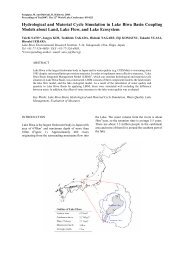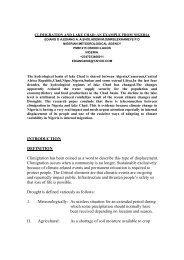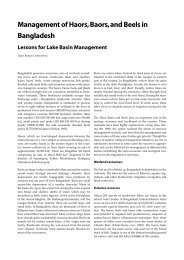Diversity of Fresh water algae in two Lakes of Tumkur, Karnataka ...
Diversity of Fresh water algae in two Lakes of Tumkur, Karnataka ...
Diversity of Fresh water algae in two Lakes of Tumkur, Karnataka ...
You also want an ePaper? Increase the reach of your titles
YUMPU automatically turns print PDFs into web optimized ePapers that Google loves.
<strong>Diversity</strong> <strong>of</strong> <strong>Fresh</strong> <strong>water</strong> <strong>algae</strong> <strong>in</strong> <strong>two</strong> <strong>Lakes</strong> <strong>of</strong> <strong>Tumkur</strong>, <strong>Karnataka</strong> State, India.<br />
Ravishankar, H.G 1 . Panduranga Murthy, G*., Lokesh, S 2 and Hosmani, S.P 3<br />
* Department <strong>of</strong> Studies <strong>in</strong> Biotechnology & Eng<strong>in</strong>eer<strong>in</strong>g<br />
Shridevi Institute <strong>of</strong> Eng<strong>in</strong>eer<strong>in</strong>g & Technology, (Affiliated to VTU & Kuvempu university, Shimoga)<br />
Sira Road, <strong>Tumkur</strong> -572 106, <strong>Karnataka</strong>, India<br />
1. Researcher, Department <strong>of</strong> Biology, Maharaja’s College, Mysore, India. 2. DOS <strong>in</strong> Biotechnology, University <strong>of</strong> Mysore, MGM-570 006.<br />
3. Pr<strong>of</strong>essor & Head, Dept. <strong>of</strong> Biotechnology, Mahajana’s First Grade College, Jayalakshmipuram, Mysore-570 012, India.<br />
Abstract<br />
Key Words: <strong>Diversity</strong>, <strong>Fresh</strong> Water Algae, <strong>Lakes</strong>, <strong>Tumkur</strong>, India<br />
<strong>Fresh</strong><strong>water</strong> <strong>algae</strong> are among the most diverse and ubiquitous organisms on earth. They occupy an<br />
enormous range <strong>of</strong> ecological conditions from lakes and rivers to acidic peat swamps, <strong>in</strong>land sal<strong>in</strong>e lakes,<br />
snow and ice, damp soils, wetlands etc. Algae <strong>in</strong> fresh <strong>water</strong>s have numerous environmental functions<br />
and are based upon the recycl<strong>in</strong>g <strong>of</strong> nutrients. Urbanization has led to the pollution <strong>of</strong> surface <strong>water</strong><br />
bodies result<strong>in</strong>g <strong>in</strong> decl<strong>in</strong>e/ext<strong>in</strong>ction <strong>of</strong> some species. On the other hand, some species have <strong>in</strong>creased<br />
enormously mak<strong>in</strong>g <strong>water</strong> unfit for dr<strong>in</strong>k<strong>in</strong>g and recreation.<br />
This paper presents data on the algal biodiversity <strong>of</strong> <strong>two</strong> fresh <strong>water</strong> lakes, Bugudana Halli Lake<br />
and Mydala Lake situated with<strong>in</strong> the boundary <strong>of</strong> <strong>Tumkur</strong> City, <strong>Karnataka</strong>, India. The study reveals,<br />
Physico-chemical parameters <strong>of</strong> <strong>two</strong> fresh <strong>water</strong> lakes and their relation to the growth and distribution <strong>of</strong><br />
planktonic population have been evaluated by standard procedures. The taxonomic account <strong>of</strong> <strong>algae</strong> with<br />
eight different groups has been recorded <strong>in</strong> order to enumerate the biodiversity <strong>of</strong> both <strong>Lakes</strong> <strong>of</strong> <strong>Tumkur</strong>.<br />
Camera Lucida draw<strong>in</strong>gs and photographs have been taken and identified to species level us<strong>in</strong>g<br />
monographs and research publications.<br />
About 171 algal species belong<strong>in</strong>g to Chlorophyceae, Bacillariophyceae, Desmidiaceae,<br />
Euglenophyceae, Cyanophyceae species have been described along with Photomicrographs and Camera<br />
Lucida draw<strong>in</strong>gs, respectively. Besides, the frequency distribution <strong>of</strong> various <strong>algae</strong> has been analyzed.<br />
The species <strong>of</strong> Pediastrum and Scenedesmus were most frequent among Chlorophyceae. The<br />
Bacillariophyceae members were dom<strong>in</strong>ated by Cymbella, Nitzschia, P<strong>in</strong>nularia and Navicula. Among<br />
Cyanophyceae, Lyngbya, Chroococcus and Oscillatoria were abundant. Desmids were represented by a<br />
large number <strong>of</strong> Cosmarium and Closterium. Euglena (13), Phacus (9) and Trachelomonas (3) <strong>of</strong><br />
Euglenophyceae were recorded. Chrysophyceae and D<strong>in</strong>ophyceae were completely absent.<br />
1
Of 171 algal species, Euglena with 14 species ranked first. Abundance <strong>of</strong> Euglenaceae and<br />
Cyanophyceae resulted <strong>in</strong> blooms which may be the ma<strong>in</strong> reason for the decl<strong>in</strong>e <strong>of</strong> other plankton<br />
population. The majority <strong>of</strong> the taxa were Bacillariophyceae (32%), while the Chlorophytes represented<br />
about 21.60%. Similarly, the other groups are Cyanophyceae-17.63%, Desmidiaceae - 12.65% and<br />
Euglenophyceae-18.26%. Interest<strong>in</strong>gly, Chrysophyceae and D<strong>in</strong>ophyceae groups were absent. As a<br />
whole, the taxonomic structure is typical <strong>of</strong> mesotrophic to eutrophic but, some taxa may be considered<br />
characteristic <strong>of</strong> oligotrophic lakes. In conclusion, more attention should be paid to this group <strong>of</strong><br />
organisms, s<strong>in</strong>ce these <strong>two</strong> <strong>Lakes</strong> are rich <strong>in</strong> rare <strong>algae</strong> species which represent important part <strong>of</strong><br />
ecosystem. Hence, the application <strong>of</strong> protection measures <strong>of</strong> rare and significant <strong>algae</strong> should be started<br />
through regular removal <strong>of</strong> bloom form<strong>in</strong>g <strong>algae</strong> from lakes and by algicide application may be useful <strong>in</strong><br />
controll<strong>in</strong>g bloom which <strong>in</strong> turn may facilitate the growth <strong>of</strong> other <strong>algae</strong>. Therefore, the ma<strong>in</strong> objective<br />
<strong>of</strong> this study, ‘preservation <strong>of</strong> algal diversity’ can be achieved.<br />
Introduction<br />
The utilization <strong>of</strong> lentic <strong>water</strong> bodies for domestic use like, dr<strong>in</strong>k<strong>in</strong>g purpose has assumed<br />
importance <strong>in</strong> develop<strong>in</strong>g countries. The disposal <strong>of</strong> agricultural waste and untreated sewage <strong>in</strong>to <strong>water</strong><br />
bodies adversely affect the plant and animal life. Sukumaran (2002) is <strong>of</strong> the op<strong>in</strong>ion that the constant<br />
discharge <strong>of</strong> sewage <strong>in</strong>to the aquatic system enriches the organic content, lead<strong>in</strong>g to eutrophication and<br />
deterioration <strong>of</strong> the quality <strong>of</strong> <strong>water</strong>. In India, <strong>in</strong>land <strong>water</strong> bodies attracted the attention <strong>of</strong> various<br />
workers lead<strong>in</strong>g to the studies on <strong>water</strong> quality and distribution <strong>of</strong> phytoplankton from time to time,<br />
(Zafar, 1967, Munawar 1974; Dwivedi and Pandey, 2002 and Ratha et al, 2003). Although<br />
considerable work has been done on the limnological studies on some tanks and ponds <strong>of</strong> <strong>Karnataka</strong>, the<br />
tanks, Mydala-Amanikere and Bugudana Halli lakes <strong>of</strong> <strong>Tumkur</strong> City is selected for the present study<br />
rema<strong>in</strong>s scientifically unexplored.<br />
In the present <strong>in</strong>vestigation, data on morphometric features, <strong>water</strong> quality parameters, density<br />
and diversity <strong>of</strong> phytoplankton communities with special reference to diversity <strong>of</strong> Algae have been<br />
gathered. Based on this data, an attempt has been made to asses the quality <strong>of</strong> <strong>water</strong> and to evaluate the<br />
trophic status <strong>of</strong> the lake.<br />
2
Materials and Methods<br />
The present study was conducted dur<strong>in</strong>g summer season <strong>of</strong> 2008-2009 at <strong>two</strong> <strong>Lakes</strong> <strong>of</strong> <strong>Tumkur</strong> City,<br />
<strong>Karnataka</strong>, India. The analysis was carried-out at Shridevi Research and Development Centre, SIET,<br />
<strong>Tumkur</strong>, India.<br />
Mydala Lake and Bugudana halli lake <strong>of</strong> <strong>Tumkur</strong> City are fresh <strong>water</strong> body situated towards<br />
north-east and south-east and are 8-10 kms from the centre <strong>of</strong> <strong>Tumkur</strong> city. It lies at 13 ° 18 ¢ north<br />
latitude and 76 ° 57 ¢ east longitude. Both are comparably large sized tanks with a <strong>water</strong> spread area <strong>of</strong><br />
370 hectares. The average depth <strong>of</strong> the tank is 3.0 to 4.4 meters along the bund. The tank is ra<strong>in</strong> fed<br />
dur<strong>in</strong>g monsoon period. These tanks are also fed by Cauvery and Hemavati canal <strong>water</strong> respectively.<br />
The <strong>water</strong> <strong>of</strong> both tanks is ma<strong>in</strong>ly used for dr<strong>in</strong>k<strong>in</strong>g purpose and also to cultivate paddy crops <strong>in</strong> and<br />
around the Lake area. Besides, wash<strong>in</strong>g activity is commonly seen and many aquatic weeds such as<br />
Ipomea aquatica, Ipomea batata, Lantana sps., Nelumbo, Cyperus sp, Pistia, Eichhornia are also seen at<br />
both tanks.<br />
The total catchment area <strong>of</strong> the tank, Mydala Lake is 62.96 sq.km, Atchkat area is 472 HA &<br />
Height is about 13-14.8m with an average ra<strong>in</strong>fall is 640.27mm and Bugudana Halli Lake is 540 akres,<br />
depth is about 15-20 feet with an average annual ra<strong>in</strong>fall <strong>of</strong> 677 mm. The tanks are irregular <strong>in</strong> shape<br />
and <strong>water</strong> <strong>in</strong> the tank is held by a raised north-south and east-east to north west bunds respectively.The<br />
soil <strong>in</strong> the catchment area <strong>of</strong> both tanks is black clay/ loamy and sand / gravel type respectively.<br />
Phytoplankton samples were collected from Surface <strong>water</strong> samples <strong>of</strong> identified stations <strong>of</strong> both<br />
lakes at a depth <strong>of</strong> more than one feet us<strong>in</strong>g polythene cans <strong>of</strong> <strong>two</strong> liter capacity, bottles and small vials<br />
at <strong>two</strong> fresh <strong>water</strong> lakes; Mydala Lake and Bugudana halli Lake <strong>of</strong> <strong>Tumkur</strong> City (Fig. 1). Samples were<br />
obta<strong>in</strong>ed from the subsurface layer and <strong>in</strong> some cases from a depth <strong>of</strong> 1 or 2 m, us<strong>in</strong>g a peristaltic pump.<br />
Additional samples taken with a 15 pm net were collected as a complement for taxonomic<br />
identifications. For the enumeration <strong>of</strong> phytoplankton, all the liv<strong>in</strong>g specimens were studied at SIET<br />
R&D Station and a set <strong>of</strong> samples were preserved with 4% formal<strong>in</strong> <strong>in</strong> PVC flasks and simultaneously<br />
with 20 ml <strong>of</strong> 1% lugol’s solution for sedimentation. These sedimented samples were observed under<br />
microscope for algal diversity and the diagrams were drawn with the help <strong>of</strong> camera<br />
lucid technique. The identification <strong>of</strong> phytoplankton up to the level <strong>of</strong> species was made with the help<br />
<strong>of</strong> literature cited [Philipose M.T (1967), Deshikachary (1959), Gandhi (1955)]. Trophic status <strong>of</strong> the<br />
lake was assessed us<strong>in</strong>g Nygaard's <strong>in</strong>dices.<br />
3
At each sampl<strong>in</strong>g site, temperature, pH and conductivity were measured with Luftman P300 and<br />
C400 comb<strong>in</strong>ed electronic meters, Filterable reactive phosphate was determ<strong>in</strong>ed accord<strong>in</strong>g Mackereth et<br />
al, (1978). The pH was measured on the spot us<strong>in</strong>g pH paper and later confirmed <strong>in</strong> the laboratory us<strong>in</strong>g<br />
digital pH meter. The chemical analysis was carried out follow<strong>in</strong>g the methods suggested by Trivedy<br />
and Goel (1986) and standard methods <strong>of</strong> APHA (1995).<br />
Fig. -1. Geographical location <strong>of</strong> <strong>Tumkur</strong> (City) District<br />
Results and Discussion<br />
The place <strong>Tumkur</strong> situated <strong>in</strong> Karanataka, India, its geographical coord<strong>in</strong>ates are 13 0 2 0 ’ 32’’<br />
North, 77 0 6’ 6’’ East and its orig<strong>in</strong>al name (with districts) is <strong>Tumkur</strong>. In the present study, the features<br />
<strong>of</strong> both <strong>Lakes</strong>, Mydala-Amanikere and Bugudana halli <strong>Lakes</strong> <strong>of</strong> <strong>Tumkur</strong> City has been represented <strong>in</strong><br />
the Table-1. Maximum and m<strong>in</strong>imum values for each physical and chemical parameter are shown <strong>in</strong><br />
Table-2. The complete floristic list is presented <strong>in</strong> Table 11& 12, and <strong>in</strong>cludes details <strong>of</strong> the Algal<br />
distribution <strong>of</strong> each taxon. In general, Bourrelly’s Systematic scheme (1970, 1972, and 1981) is used,<br />
except <strong>in</strong> the case <strong>of</strong> Bacillariophyceae when Simonsen (1979) is followed. A total <strong>of</strong> 171 algal taxa<br />
were recorded and are represented <strong>in</strong> the Tables 11and 12 respectively. Some <strong>of</strong> the algal taxa recorded<br />
present problems <strong>in</strong> their taxonomic identification. In particular, some taxa were cultured <strong>in</strong> the<br />
laboratory and are photomicrographed f<strong>in</strong>ally presented <strong>in</strong> the table format. The physico-chemical and<br />
biological parameters are presented <strong>in</strong> Table-3.<br />
4
Most <strong>of</strong> the species recorded <strong>in</strong> both <strong>Lakes</strong> <strong>of</strong> <strong>Tumkur</strong> City have already been found <strong>in</strong> other<br />
parts like, Mysore, Mandya, Bangalore, Chamaraja nagar districts respectively confirm<strong>in</strong>g the wide<br />
distribution <strong>of</strong> the fresh<strong>water</strong> <strong>algae</strong> with<strong>in</strong> this region. Nevertheless, sixteen <strong>of</strong> them are new records. On<br />
the basis <strong>of</strong> the geographical distribution from literature data 60% <strong>of</strong> the species listed here are wide<br />
spread. Among the algal groups treated <strong>in</strong> this paper, the Bacillariophyceae showed the highest species<br />
richness with 52 taxa; some <strong>of</strong> these species were polymorphic (e.g. P<strong>in</strong>nularia microstauron and<br />
Nuvicula muticopsis). Chlorophyceae comprised 46 species, Euglenaceae comprises 27 sps, and<br />
Desmidiaceae comprises 22 sps repectively, with Chlorococcales as the most diverse order (Table-3 and<br />
4 -7).<br />
‘Cyanophyceae’ is well represented <strong>in</strong> both <strong>Lakes</strong> <strong>of</strong> <strong>Tumkur</strong> (Izaguirre et al. 1993; Bais et al,<br />
1995; Chaturvedi and Iqbal Habib, 1995; Dwivedi and Pandey, 2002 and Ratha et al, 2003). These class<br />
comprises several polymorphic filamentous taxa, most <strong>of</strong> them form<strong>in</strong>g part <strong>of</strong> the algal mats present <strong>in</strong><br />
lakes. This fact justifies the separate study <strong>of</strong> this particular group. The species recorded was 24 sps<br />
found <strong>in</strong> phytoplankton samples, but some <strong>of</strong> them are typically epilithic or are usually associated with<br />
the large stones and humid/ loamy soils. They may be transported <strong>in</strong>to the <strong>water</strong>-bodies by w<strong>in</strong>d, <strong>water</strong><br />
run<strong>of</strong>f and birds (Table-3 & 8).<br />
Phytoplankton population <strong>in</strong> both tanks <strong>of</strong> <strong>Tumkur</strong> is composed <strong>of</strong> five major groups namely<br />
Chlorophyceae, Bacillariophyceae, Euglenophyceae, Cyanophyceae and Desmidiaceae. The density <strong>of</strong><br />
phytoplankton shows that Bacillariophyceae dom<strong>in</strong>ated and constituted (31.12%) <strong>of</strong> total phytoplankton<br />
population followed by Chlorophyceae (26.39%-Table-), Euglenophyceae, (16.36%), Cyanophyceae<br />
(14.86%) and Desmidiaceae (11.25%). In the present study, the maximum density <strong>of</strong> <strong>algae</strong> was noticed<br />
<strong>in</strong> May, June and July - 74714 Organisms/ Litre <strong>in</strong> Mydala-Amanikere lake and <strong>in</strong> Bugudanahalli Lake,<br />
the total algal diversity was found to be, 89910 (Table- 3& 9).<br />
The average density <strong>of</strong> Chlorococcales was found to be 12930 Org / L <strong>in</strong> Mydala-Amanilake and<br />
15480 Org / L were present <strong>in</strong> Bugudanahalli Lake. The density <strong>of</strong> Bacillariophyceae <strong>in</strong> Mydala-<br />
Amanilake was found to be, 29750 Org / L and 23640 Org / L was present Bugudanahalli Lake.<br />
Similarly, the average density <strong>of</strong> Desmids was 11200 Org / L present <strong>in</strong> Mydala-Amani lake and 6680<br />
Org / L <strong>in</strong> Bugudanahalli lake. The average density <strong>of</strong> Euglenoids was found to be 2984 Org / L <strong>in</strong><br />
Mydala-Amani Lake and 9120 Org / L <strong>in</strong> Bugudanahall lakes <strong>of</strong> <strong>Tumkur</strong> City. Besides, the average<br />
5
density <strong>of</strong> Cyanaphycean members was found to be 12600 Org / L <strong>in</strong> Mydala-Amanilake and 26840 Org<br />
/ L <strong>in</strong> Bugudanahalli Lake were represented (Table-3).<br />
The data obta<strong>in</strong>ed on the diversity <strong>of</strong> Algae <strong>in</strong> <strong>two</strong> fresh <strong>water</strong> lakes <strong>of</strong> <strong>Tumkur</strong> City is ma<strong>in</strong>ly<br />
based on the factors <strong>of</strong> both <strong>in</strong>ternal and external respectively. The <strong>water</strong> temperature plays an important<br />
role <strong>in</strong> controll<strong>in</strong>g the occurrence and abundance <strong>of</strong> phytoplankton (Nazneen, 1980). Bugudanahalli<br />
Lake as compared to Mydala-Amani-lake was noticed dur<strong>in</strong>g the pre-monsoon period could be<br />
attributed to <strong>in</strong>creased temperature and light dur<strong>in</strong>g this season as suggested by Kopoczynska (1980) and<br />
Dwivedi and Pandey, 2002.<br />
Verma and Mohanty (1995) have reported a direct relation ship between pH and<br />
phytoplankton. Robert et.al., (1974) suggested that pH 5 to 8.5 is ideal for phytoplankton growth and<br />
this was found to be true <strong>in</strong> the present <strong>in</strong>vestigation. Zafar <strong>in</strong> 1967 was <strong>of</strong> the op<strong>in</strong>ion that, calcium is<br />
one <strong>of</strong> the important elements <strong>in</strong>fluenc<strong>in</strong>g the distribution <strong>of</strong> Bacillariophyceae. In the present<br />
<strong>in</strong>vestigation calcium ranges between 39 to 78 mg /L favor<strong>in</strong>g the dom<strong>in</strong>ance <strong>of</strong> Bacillariophyceae (52<br />
species). This is <strong>in</strong> agreement with the f<strong>in</strong>d<strong>in</strong>gs <strong>of</strong> Zafar, 1967 and Y<strong>in</strong>g Ouyang, 2005.<br />
Presence <strong>of</strong> Microcystis and Anabaena, high alkal<strong>in</strong>ity and hardness <strong>in</strong>dicates the trend <strong>of</strong> the<br />
<strong>water</strong> body towards eutrophication. In the present <strong>in</strong>vestigation alkal<strong>in</strong>ity ranges between 14 to 23 mg/L<br />
and the total hardness ranges between 114 to 399 mg/Liter. Microcystis and Anabaena were recorded <strong>in</strong><br />
all the months <strong>of</strong> the study period. This is <strong>in</strong> agreement with the f<strong>in</strong>d<strong>in</strong>gs <strong>of</strong> Sankaran Unni, 1982 and<br />
Chaturvedi & Iqbal Habib, 1995; and Ratha et al, 2003.<br />
Munawar (1974) study shows a direct relationship between concentration <strong>of</strong> silicates and the<br />
density <strong>of</strong> diatoms. In the present <strong>in</strong>vestigation, the Silica content was low and ranged between 0.091 to<br />
0.214 mg/L, yet the <strong>water</strong> body harbored considerable number <strong>of</strong> diatoms. This <strong>in</strong>dicates that, the<br />
concentration <strong>of</strong> silica is not the only parameter that regulates the diatoms population <strong>in</strong> the <strong>water</strong> body.<br />
Similar f<strong>in</strong>d<strong>in</strong>gs were also made by Hosmani et al, 1999 and Y<strong>in</strong>g Ouyang, 2005. Some <strong>of</strong> the<br />
phytoplankton <strong>in</strong>dicat<strong>in</strong>g the eutrophic status <strong>of</strong> the tank encountered dur<strong>in</strong>g the study is listed below.<br />
Euglena, Oscillatoria, Scenedesmus, Nitzschia, Navicula, Synedra, Ankistrodesnus, Phacus,<br />
Phormidium, Melosira, Gomphonema, Cyclotella and Anabaena<br />
6
Conclusion<br />
Algae <strong>in</strong> fresh <strong>water</strong>s have numerous environmental functions and are based upon the recycl<strong>in</strong>g<br />
<strong>of</strong> nutrients. Urbanization has led to the pollution <strong>of</strong> surface <strong>water</strong> bodies result<strong>in</strong>g <strong>in</strong> decl<strong>in</strong>e/ext<strong>in</strong>ction<br />
<strong>of</strong> some species. On the other hand, some species have <strong>in</strong>creased enormously mak<strong>in</strong>g <strong>water</strong> unfit for<br />
dr<strong>in</strong>k<strong>in</strong>g and recreation.<br />
Ample <strong>of</strong> work is done either on taxonomic account or limnological account; but studies on the<br />
comb<strong>in</strong>ed aspects is lack<strong>in</strong>g. Information on the algal biodiversity and related aspects perta<strong>in</strong><strong>in</strong>g to the<br />
<strong>water</strong> bodies <strong>in</strong> <strong>Karnataka</strong> state is unavailable. The present study reveals the importance <strong>of</strong> physico-<br />
chemical parameters and their effect on algal biodiversity <strong>in</strong> selected fresh <strong>water</strong> <strong>Lakes</strong> <strong>of</strong> <strong>Tumkur</strong> City.<br />
Of 171 algal species, the abundance <strong>of</strong> both Euglena with 27 species and Cyanophyceae<br />
with 24 species resulted <strong>in</strong> blooms which may be the ma<strong>in</strong> reason for the decl<strong>in</strong>e <strong>of</strong> other plankton<br />
population. Beides, the Bacillariophyceae is the dom<strong>in</strong>at<strong>in</strong>g group with 31.12% followed by 26.39% <strong>of</strong><br />
Chlorophyceae. The other groups are Cyanophyceae -14.86%, Desmidiaceae-11.25% and<br />
Euglenophyceae-16.36%. Interest<strong>in</strong>gly, the members <strong>of</strong> Chrysophyceae and D<strong>in</strong>ophyceae were<br />
completely absent. Hence, <strong>in</strong> order to conserve the <strong>two</strong> lakes <strong>of</strong> <strong>Tumkur</strong> City, regular removal <strong>of</strong> bloom<br />
form<strong>in</strong>g <strong>algae</strong> from both <strong>Lakes</strong> by algicide application may be useful <strong>in</strong> controll<strong>in</strong>g bloom which <strong>in</strong> turn<br />
may facilitate the growth <strong>of</strong> other <strong>algae</strong> and po<strong>in</strong>t to be noted that, “Preserv<strong>in</strong>g algal diversity" is the<br />
ma<strong>in</strong> significant out-put <strong>of</strong> the present study.<br />
Acknowledgement<br />
We thank the Shridevi R&D Centre for support<strong>in</strong>g the present Research work. We are grateful to<br />
Dr. M.R. Hul<strong>in</strong>ayakar, Shridevi Charitable Trust, <strong>Tumkur</strong>, India for his valuable co-operation and<br />
counsel. We also thank Dr. M.A. Venkatesh, Pr<strong>in</strong>cipal, SIET, <strong>Tumkur</strong>, India for constant support<br />
dur<strong>in</strong>g the course <strong>of</strong> Investigation.<br />
7
References<br />
APHA, AWWA 1985. Standard. Methods for the exam<strong>in</strong>ation <strong>of</strong> <strong>water</strong> & waste <strong>water</strong>. Wash<strong>in</strong>gton DC<br />
18th Edition.<br />
Anilkumar S.,2000. “<strong>Fresh</strong> <strong>water</strong> Algae <strong>of</strong> Hassan District, <strong>Karnataka</strong> state”, India, Ph.D.Thesis.<br />
Bais V.S., N.C.Agarwal, and Arasta Tazeen (1995) “Comparative study on seasonal changes <strong>in</strong><br />
phytoplankton community <strong>in</strong> the Sagar lake and Military Eng<strong>in</strong>eer<strong>in</strong>g lake”. J. <strong>Fresh</strong><strong>water</strong> Bio. 7(1) :<br />
19-25.<br />
Chaturvedi U.K. and Iqbal Habib 1995 algal flora <strong>of</strong> Sr<strong>in</strong>agar (Garhwal) Uttar Pradesh.U.P. Phykos 25:<br />
p.129-127.<br />
Dwivedi, B.K.and G.C.Pandey 2002. Physico-chemical factors and algal diversity <strong>of</strong> <strong>two</strong> ponds<br />
<strong>in</strong>Faizabad, India Poll.Res.21(3):361-370.<br />
Guruswamy, K.and V.Ramadass 2000. Seasonal variation <strong>of</strong> Chlorophyll and phytoplankton<br />
productivity <strong>in</strong> man made pond.J.Ecobiol. 12(4):p.281-287.<br />
Hosmani S.P., L.Vasanthakumar and S.Partha 1999.Ecological significance <strong>of</strong> biochemical parameters<br />
<strong>in</strong> certa<strong>in</strong> fresh <strong>water</strong> lakes <strong>of</strong> Mysore. Journal <strong>of</strong> Environmental Biology 20(2):p. 121-124.<br />
Hosmani, S.P. 2002.Phytoplankton – zooplankton relationship <strong>in</strong> four fresh <strong>water</strong> bodies <strong>of</strong> Dharwad.<br />
Indian J. Environ. & Ecoplan. 6(1): p.23-28.<br />
Harikrishnan K., Thomas Sabu, George Sanil, R.Paul Murugan, Mandyayoor Satish and M.R.Das 1999<br />
A study on the distribution and ecology <strong>of</strong> phytoplankton <strong>in</strong> the Kutt and Wetland ecosystem, Kerala.<br />
Poll. Res. 18(3): p.261-269.<br />
Kaur, H.,K.S. Bath,G.Mander and N.Jerath 2000. Physico chemical status <strong>of</strong> Kanjli wetland (Punjab)<br />
India. J.Envi.and Poll. 7(1):p.39 – 42.<br />
Kopoczynska E.E. 1980. Seasonal variation <strong>in</strong> phytoplankton <strong>in</strong> the grand river mouth area <strong>of</strong> lake<br />
Michigan. Pol.Arch. Hydrobiol. 27(1):95-123.<br />
Mahadev J. and S.P. Hosmani, 2002 Langlier’s <strong>in</strong>dex and relation to phytoplankton <strong>in</strong> <strong>two</strong> lakes <strong>of</strong><br />
Mysore city. Nature, Environment and Pollution Technology, 1(1)19-21.<br />
Munawar M. 1974. Limnological studies on fresh <strong>water</strong> ponds <strong>of</strong> Hyderabad, India. Biocenase Ibid,<br />
45, 1-32.<br />
Nazneen S. 1980. Influence <strong>of</strong> hydrological factors on seasonal abundance <strong>of</strong> phytoplankton <strong>in</strong> K<strong>in</strong>jhar<br />
Lake, Pakistan.Int. Revu.Ges. Hydrabiol. 65(2): 269-282.<br />
8
Philipose M.T. 1960. <strong>Fresh</strong> <strong>water</strong> phytoplankton <strong>of</strong> <strong>in</strong>land fisheries. Proc. Symp. Algol. ICAR, New<br />
Delhi. 272 – 291.<br />
Ratha, S.K., K.Naik and S.B.Padhi 2003. Epiphytic algal diversity associated with different aquatic<br />
macrophytes <strong>of</strong> fresh <strong>water</strong> ponds <strong>in</strong> and around Berhampur university campus, Orissa, India. Nat.<br />
Env.and Poll. Tech. vol.2 no.2: p. 205-208.<br />
Robert D.S., Robert W.H and Evereff L.G.1974. Phytoplankton distribution and <strong>water</strong> quality <strong>in</strong>dices <strong>of</strong><br />
lake head ( colorodo river). Phycol, 10: 232 – 333.<br />
Saha, L.C. and S.K. Choudhary 1985. Phytoplankton diversity <strong>in</strong> relation to abiotic factors <strong>of</strong> a pond at<br />
Bagalpur, India. Comp.Physiol.Ecol: 109:598-600.<br />
Sankaran Unni K. 1982. Limnological studies on Sampna Reservoir, Betul, M.P. Proc. Nat. Acad. Sci.<br />
India, 52(B), IV. 365-372.<br />
Shi Zhi-X<strong>in</strong> 1996. Qualitataive analysis on Euglenoid distribution <strong>in</strong> seven regions <strong>of</strong> Ch<strong>in</strong>a.<br />
Hydrobiologia 336: p.55-65.<br />
Sukumaran P.K. 2002. Aquatic micr<strong>of</strong>lora <strong>in</strong> a perennial tank <strong>in</strong> Bangalore. Envt. and Ecol. 20(1) : 8-12.<br />
Tarar, J.L. and Seema Bodkhe 1998b. Diatom flora <strong>of</strong> polluted <strong>water</strong> bodies <strong>of</strong> Nagpur. Phykos<br />
37(1&2): p.77-86.<br />
Trivedy R.K and Goel P.K. 1986. Chemical and Biological methods for <strong>water</strong> pollution studies.<br />
Vasconcellos. 1994. Toxic cyanobacteria (blue-green <strong>algae</strong>) <strong>in</strong> Portuguese fresh <strong>water</strong>s.<br />
Archiv.fur.Hydrobiologia 130: 4, 439-451.<br />
Verma J and Mohanty R.C. 1995 phytoplankton and its correlation with certa<strong>in</strong> physico-chemical<br />
parameters <strong>of</strong> Danmukundpur pond. Poll.Res. 14(2): 233-242.<br />
Y<strong>in</strong>g Ouyang, 2005. Evaluation <strong>of</strong> <strong>water</strong> quality monitor<strong>in</strong>g stations by pr<strong>in</strong>cipal component analysis.<br />
Water Research 39: 2621-2635.<br />
Zafar A.R 1967. On ecology <strong>of</strong> <strong>algae</strong> <strong>in</strong> certa<strong>in</strong> fish ponds <strong>of</strong> Hyderabad, India-III. The periodicity.<br />
Hydrobiol. 30, 96-112.<br />
9
Sl.<br />
No.<br />
Table 01: Features <strong>of</strong> <strong>Fresh</strong> <strong>water</strong> <strong>Lakes</strong> <strong>of</strong> <strong>Tumkur</strong> City<br />
Place Area <strong>of</strong><br />
<strong>Lakes</strong><br />
Achkat<br />
Area<br />
Height<br />
Average<br />
Ra<strong>in</strong> fall<br />
Bas<strong>in</strong> <strong>of</strong><br />
Tank<br />
1. Mydala-Amani Lake 213.66 472.00 HA 13.80m 640.27mm Cauvery<br />
2. Bugudana halli Lake 242.80 540.00 HA 16-19feet 667.44mm Hemavathi<br />
Table -02. Maximum and m<strong>in</strong>imum values <strong>of</strong> the physical and chemical characteristics for each<br />
lake, correspond<strong>in</strong>g to the study period (Jan - August, 2009)<br />
Lake Temperature<br />
( 0 C)<br />
PH, Conductivity<br />
(micro<br />
second/cm)<br />
Filterable reactive<br />
phosphate<br />
(microgram/litre)<br />
river<br />
river<br />
Trophic<br />
Status<br />
Mydala lake 0-0.9 5.3-6 45.4-170 312.2-1030.9 Meso to<br />
Bugudana<br />
halli Lake<br />
· Only one sample<br />
Eutrophic<br />
0- 4 5.5-7 10-91.3 14.8-970.5 Oligo to<br />
Mesotrophic<br />
Table – 09 – Distribution total Algal groups <strong>in</strong> both lakes dur<strong>in</strong>g th period <strong>of</strong> Jan - August, 2009.<br />
Algal group Total Number <strong>of</strong> species Percentage<br />
Chlorophyceae 46 26.396<br />
Bacillariophyceae 52 31.124<br />
Euglenaceae 27 16.361<br />
Cyanophyceae 24 14.863<br />
Desmidiaceae 22 11.254<br />
Total 171 99.998<br />
10
Table -03: Physico-chemical and biological parameters <strong>of</strong> <strong>two</strong> <strong>Lakes</strong> <strong>of</strong> <strong>Tumkur</strong> City<br />
SL. No. Parameters<br />
Mydala-Amani<br />
Lake<br />
1 Atmospheric temp. o C 27 25<br />
2 Water temp. o C 26 26<br />
3 Color Little bit muddy Clear<br />
4 Turbidity No No<br />
5 pH 8.6 8.5<br />
8 Dissolved oxygen mg/L 8.97 11.28<br />
9 Carbon dioxide mg/L 16.79 9.44<br />
10 Total alkal<strong>in</strong>ity mg/L 245 265<br />
11 Phenolphthale<strong>in</strong> alkal<strong>in</strong>ity mg/L 34 08<br />
12 Methyl orange acidity mg/L 0 0<br />
13 Phenolphthale<strong>in</strong> acidity mg/L 18 35<br />
14 Hardness mg/L 136 185<br />
15 Calcium mg/L 24.66 36.34<br />
16 Nitrates mg/L 0.017 0.031<br />
17 Nitrites mg/L 0.012 0.16<br />
18 Phosphates mg/L 0.110 0.19<br />
19 Silicate mg/L 0.092 0.214<br />
19 Chlorides mg/L 49.6 68.38<br />
21 Total Solids mg/L 945 730<br />
22 Mg++ mg/L 32.2 23.66<br />
23 Chlorophyceae 5250 8150<br />
24 Bacillariophyceae 29750 23640<br />
25 Cyanophyceae 12600 26840<br />
26 Desmidiaceae 11200 6680<br />
27 Chlorococcales 12930 15480<br />
28 Euglenaceae 2984 9120<br />
29 Chrysophaceae 0 0<br />
30 D<strong>in</strong><strong>of</strong>lagellates 0 0<br />
Bugudana Halli<br />
Lake<br />
11
Table - 10. Algal diversity represented <strong>in</strong> Plates<br />
SL.<br />
No.<br />
Plate -1 Plate -2<br />
01 Lyngbya versicolor (Wartman.) Characium obtususum<br />
Gomont<br />
A.braun<br />
02 Lyngbya semiplena (C. Ag.) Coelastrum reticulatum (Dang.)<br />
J.Ag. Ex Gomont<br />
Senn<br />
03 Lyngbya latissima Prescott Cladophora fracta var. normalis (Dillw.)<br />
Kuetz<strong>in</strong>g<br />
04 Merismopaedia convoluta<br />
de-Breb. <strong>in</strong> Kuetz.<br />
Characium limneticum Lemm.<br />
05 Lyngbya martensiana Menegh Pandor<strong>in</strong>a morum (Muell.) Bory.<br />
06 Spirul<strong>in</strong>a major (Kuetz.) gom. Oocystis gigas Archer<br />
07 Anabaena aff<strong>in</strong>is Lemm. Spirogyra fluviatilis Hilse<br />
08 Chroococcus m<strong>in</strong>utus (Kuetz.)<br />
Naegeli<br />
Pediastrum obtusum Lucks<br />
09 Chroococcus turgidus (Kuetz.) Pediastrum tetras var.<br />
Naegeli<br />
tetraodon (Corda.) Rabh.<br />
10 Chroococcus pallidus Naegeli Scenedesmus bijuga (Turp.)<br />
Lagerheim<br />
11 Gloeocapsa punctata Naegeli Scenidesmus obliques (Turp.)<br />
Kuetz.<br />
12 Anabaena spiroides Klebahn Spirogyra subsalsa Kuetz.<br />
13 Gomphosphaeria apon<strong>in</strong>a Kuetz. Spirogyra gratiana Transeau<br />
14 Merismopaedia elegans A.<br />
Braun <strong>in</strong> Kuetz.<br />
Ulothrix cyl<strong>in</strong>dricum Prescott<br />
15 Oscillatoria bornetii Zukal Tetraedron regulare Kuetz.<br />
16 Oscillatoria tennuis Ag.ex<br />
Gomont<br />
Scenedesmus bijugatus Turp.<br />
17 Oscillatoria acutissima Kufferath Zygnemopsis spiralis (Fritsch)<br />
Transeau<br />
18 Oscillatoria amoena (Kuetz.)<br />
Gom.<br />
Eudor<strong>in</strong>a elegans Ehr.<br />
19 Acnt<strong>in</strong>astrum hantzii Lagerheim ---<br />
20 Coelastrum sphaericum Naeg. ---<br />
21 Ankistrodesmus falcatus(Corda)<br />
Ralfs.<br />
---<br />
12
Table- 11. Algal diversity represented <strong>in</strong> Plates<br />
SL.<br />
No.<br />
Plate -3 Plate -4<br />
01 Closterium dianae Ehr.<br />
var.m<strong>in</strong>us (Wille) Schroeder.<br />
Gomphonema tenuis Gandhi<br />
02 Closterium cuspidatum Bail. P<strong>in</strong>nularia gibba Ehr.<br />
03 Closterium validum West &<br />
West<br />
Cymbella gracilis (Rabh.)Cleve<br />
04 Closterium libellula Focke var.<br />
elongatum (Kreig.) Scot prescot<br />
comb. Nov.<br />
Pleuro sigma hippocampus W.smith<br />
05 Cosmarium regnelli var Wille<br />
chondrophorum Skuja<br />
P<strong>in</strong>nularia conica Gandhi<br />
06 Euastrum antistrophum Scott &<br />
Prescott<br />
Diploneis puella (Schum) Cleve<br />
07 Cosmarium lundellii Delp.var. ellipticum P<strong>in</strong>nularia graciloidis Huestedt.<br />
W.West.<br />
08 Cosmarium contractum Kirchn. P<strong>in</strong>nularia card<strong>in</strong>aliculis (Cleve) Lund<br />
09 Euastrum platycerum Re<strong>in</strong>sch fa. Cymbella aspera (Ehr.) Cleve<br />
10 Euastrum s<strong>in</strong>uosum Lenorm<br />
var.capitatum Scot&Prescot.<br />
Nitzschia gracillis Hantzsch<br />
11 Euglena acus var. rigida (Ehr.)<br />
Huebner<br />
Synedra acus Kuetz.<br />
12 Euglena tripteris (Duj.)Klebs Nitzschia palea (Kuetz.) W.Smith<br />
13 Euglena ehrenbergii Klebs. Fragilaria capuc<strong>in</strong>a Dems. var.arctica<br />
A.cl.<br />
14 Phacus helikoides Pochman Nitzschia subl<strong>in</strong>earis Huestedt<br />
15 Phacus anacoelus Stokes Stauroneis angularae Gonzalves et Gandhi<br />
16 Phacus longicauda (Ehr.)<br />
Dujard<strong>in</strong><br />
Navicula similis Krasske<br />
17 Trachelomonas charkowiensis<br />
Swernkoi<br />
Navicula gracillis Ehr.<br />
18 Trachelomonas hispida(Perty)<br />
Ste<strong>in</strong><br />
Stauronies kirtikari Gandhi<br />
19 Phacus segrettii Lefevere var.<br />
ovum Prescott<br />
---<br />
20 --- ---<br />
21 --- ---<br />
13
PLATE-1 – Camera Lucida diagrams<br />
1 2 3 4 5 6 7<br />
8 9 10 11<br />
12 13 14 15 16<br />
17 18 19 20 21<br />
14
PLATE-2 -Camera Lucida diagrams<br />
1 2 3 4<br />
5 6 7 8<br />
9 10 11 12 13 14<br />
15 16 17 18<br />
15
PLATE-3- Camera Lucida diagrams<br />
1 2 3 4 5 6<br />
7 8 9 10<br />
11 12 13 14 15 16<br />
17 18 19<br />
16
PLATE-4 - Camera Lucida diagrams<br />
1 2 3 4 5 6<br />
7 8 9 10 11<br />
12 13 14 15 16 17 18<br />
17



